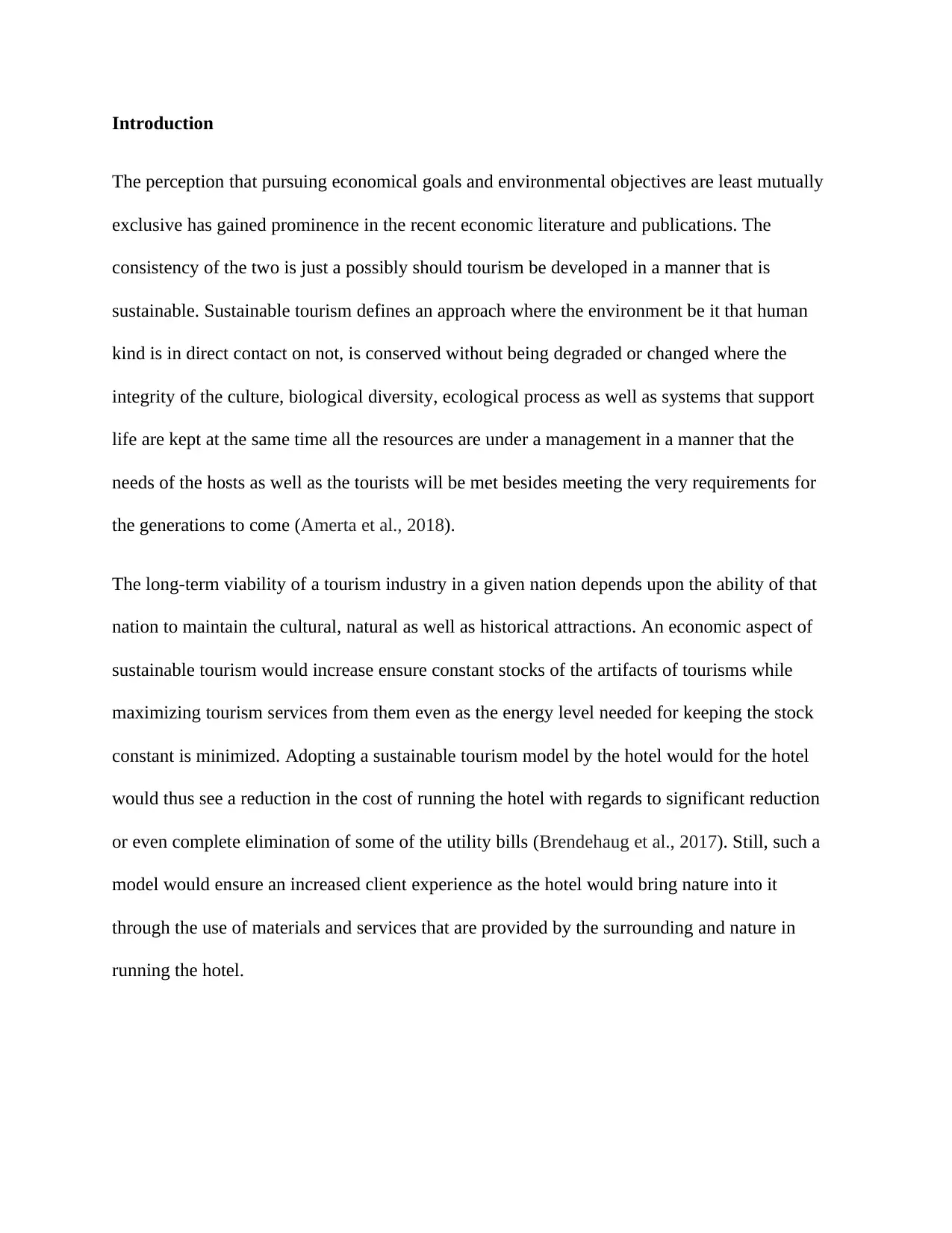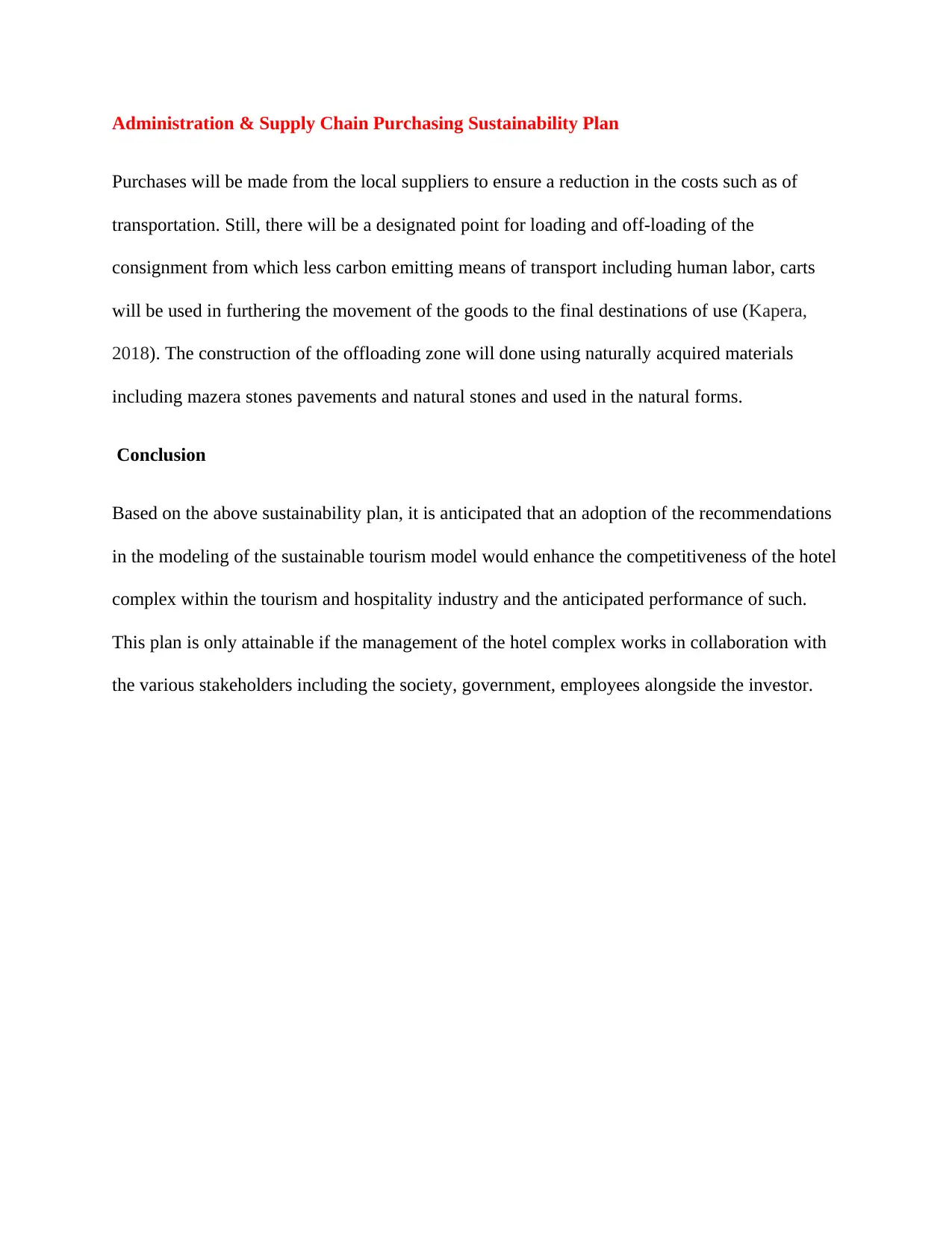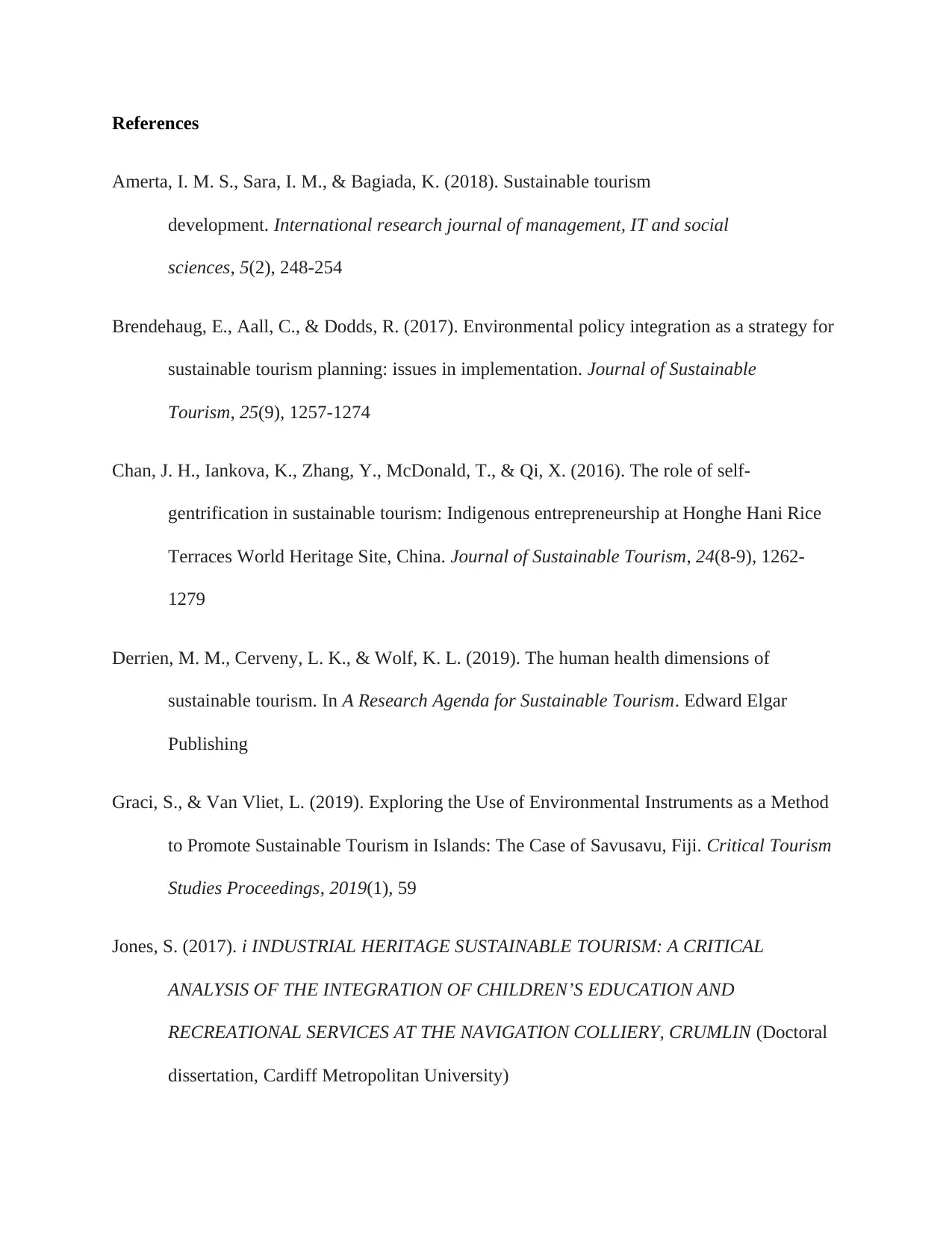Capilano University: Tourism and Climate Change Sustainability Plan
VerifiedAdded on 2022/09/18
|8
|1490
|17
Report
AI Summary
This report presents a comprehensive sustainability plan for Hotel Independent, an urban hotel aiming to become a model of environmental responsibility. The plan addresses various aspects, including guest rooms, guest services (spa, pool, exercise room), food and beverage, and administration/supply chain. The guest room section focuses on maximizing views, using natural materials, and minimizing energy consumption through design and material choices. Guest services incorporate organic pool design and the use of natural materials. The food and beverage plan emphasizes locally sourced, organic produce and waste water management. The administration and supply chain section focuses on local sourcing and the use of low-carbon transport. The plan emphasizes the financial benefits of sustainable practices, such as reduced utility costs and increased customer satisfaction, while also considering the environmental impact of tourism and climate change. The report concludes by highlighting the importance of collaboration between stakeholders for the successful implementation of the plan.

TOURISM & CLIMATE CHANGE
By Name
Course
Instructor
Institution
Location
Date
By Name
Course
Instructor
Institution
Location
Date
Paraphrase This Document
Need a fresh take? Get an instant paraphrase of this document with our AI Paraphraser

Introduction
The perception that pursuing economical goals and environmental objectives are least mutually
exclusive has gained prominence in the recent economic literature and publications. The
consistency of the two is just a possibly should tourism be developed in a manner that is
sustainable. Sustainable tourism defines an approach where the environment be it that human
kind is in direct contact on not, is conserved without being degraded or changed where the
integrity of the culture, biological diversity, ecological process as well as systems that support
life are kept at the same time all the resources are under a management in a manner that the
needs of the hosts as well as the tourists will be met besides meeting the very requirements for
the generations to come (Amerta et al., 2018).
The long-term viability of a tourism industry in a given nation depends upon the ability of that
nation to maintain the cultural, natural as well as historical attractions. An economic aspect of
sustainable tourism would increase ensure constant stocks of the artifacts of tourisms while
maximizing tourism services from them even as the energy level needed for keeping the stock
constant is minimized. Adopting a sustainable tourism model by the hotel would for the hotel
would thus see a reduction in the cost of running the hotel with regards to significant reduction
or even complete elimination of some of the utility bills (Brendehaug et al., 2017). Still, such a
model would ensure an increased client experience as the hotel would bring nature into it
through the use of materials and services that are provided by the surrounding and nature in
running the hotel.
The perception that pursuing economical goals and environmental objectives are least mutually
exclusive has gained prominence in the recent economic literature and publications. The
consistency of the two is just a possibly should tourism be developed in a manner that is
sustainable. Sustainable tourism defines an approach where the environment be it that human
kind is in direct contact on not, is conserved without being degraded or changed where the
integrity of the culture, biological diversity, ecological process as well as systems that support
life are kept at the same time all the resources are under a management in a manner that the
needs of the hosts as well as the tourists will be met besides meeting the very requirements for
the generations to come (Amerta et al., 2018).
The long-term viability of a tourism industry in a given nation depends upon the ability of that
nation to maintain the cultural, natural as well as historical attractions. An economic aspect of
sustainable tourism would increase ensure constant stocks of the artifacts of tourisms while
maximizing tourism services from them even as the energy level needed for keeping the stock
constant is minimized. Adopting a sustainable tourism model by the hotel would for the hotel
would thus see a reduction in the cost of running the hotel with regards to significant reduction
or even complete elimination of some of the utility bills (Brendehaug et al., 2017). Still, such a
model would ensure an increased client experience as the hotel would bring nature into it
through the use of materials and services that are provided by the surrounding and nature in
running the hotel.

Figure 1: Dimensions of Sustainable tourism
Guest Rooms Sustainability Plan
The guest rooms will act as the accommodation spaces for the guests during their stay within the
facility. They are therefore the spaces will determine to the greatest extent the level of customer
satisfaction with the tourism sustainability model that is adopted. The location of the guests’
rooms will do in such a way that they maximize the various attractive views of the hotel
complex. The design and construction of the guest room should be done in such a way they are
on the same side and that bordering the provincial park (Chan et al., 2016). This would the
tourists are kept in almost direct contact with the environment as they would be enjoying the
views as provided by the natural habitats including the forests and associated natural features.
Still, the construction of the guest rooms will be done using naturally acquired resources to
reduce the carbon footprint through eliminating such service as transportation of the materials to
the site. The naturally acquired raw materials should be used in their natural form without
undergoing secondary treatment including painting. This would further ground the rooms to the
natural environment.
Guest Rooms Sustainability Plan
The guest rooms will act as the accommodation spaces for the guests during their stay within the
facility. They are therefore the spaces will determine to the greatest extent the level of customer
satisfaction with the tourism sustainability model that is adopted. The location of the guests’
rooms will do in such a way that they maximize the various attractive views of the hotel
complex. The design and construction of the guest room should be done in such a way they are
on the same side and that bordering the provincial park (Chan et al., 2016). This would the
tourists are kept in almost direct contact with the environment as they would be enjoying the
views as provided by the natural habitats including the forests and associated natural features.
Still, the construction of the guest rooms will be done using naturally acquired resources to
reduce the carbon footprint through eliminating such service as transportation of the materials to
the site. The naturally acquired raw materials should be used in their natural form without
undergoing secondary treatment including painting. This would further ground the rooms to the
natural environment.
⊘ This is a preview!⊘
Do you want full access?
Subscribe today to unlock all pages.

Trusted by 1+ million students worldwide

Among the materials that can be used in the construction of the guest rooms include mazera for
the floors, wood and timber for the structural members, shingles for the roof and clay bricks for
the walls (Derrien et al., 2019). To minimize energy bills, large windows will be used to allow
maximum penetration of natural daylight during daylighting hours. The orientation of the
windows should be done in the North-South axis to avoid possible glare that would distort the
comfort of the guests during their stay.
To reduce the carbon impact of the guest houses, the construction will be done in such a way that
they are raised 500 mm above the ground level. This will ensure conservation of the existing
vegetation besides enhancing the quality of the surrounding views of the complex. The furniture
to be used in the guest rooms including seats, tables, stools and beds are as well to be made from
natural wood and timber with joinery work done on materials that are environmentally
sustainable as well as meet the structural functionality requirements (Mihalic, 2016).
Guest services Sustainability Plan
The guest services within the complex will include spa, pool, and an exercise room. The design
of the pool will be done in such a way that it functions as an organic pool. Water used in the pool
should be extracted from the ocean to ensure a linkage of the pool to the natural environment.
Organic plants should be planted around the pool to aid in the control of the micro climate
around the facility (Graci & Van Vliet, 2019). Still, the spa seats that will be used in the complex
should be made using timber and wood extracted from the natural surrounding with interference
with the natural form of the material used reduced as much as possible.
the floors, wood and timber for the structural members, shingles for the roof and clay bricks for
the walls (Derrien et al., 2019). To minimize energy bills, large windows will be used to allow
maximum penetration of natural daylight during daylighting hours. The orientation of the
windows should be done in the North-South axis to avoid possible glare that would distort the
comfort of the guests during their stay.
To reduce the carbon impact of the guest houses, the construction will be done in such a way that
they are raised 500 mm above the ground level. This will ensure conservation of the existing
vegetation besides enhancing the quality of the surrounding views of the complex. The furniture
to be used in the guest rooms including seats, tables, stools and beds are as well to be made from
natural wood and timber with joinery work done on materials that are environmentally
sustainable as well as meet the structural functionality requirements (Mihalic, 2016).
Guest services Sustainability Plan
The guest services within the complex will include spa, pool, and an exercise room. The design
of the pool will be done in such a way that it functions as an organic pool. Water used in the pool
should be extracted from the ocean to ensure a linkage of the pool to the natural environment.
Organic plants should be planted around the pool to aid in the control of the micro climate
around the facility (Graci & Van Vliet, 2019). Still, the spa seats that will be used in the complex
should be made using timber and wood extracted from the natural surrounding with interference
with the natural form of the material used reduced as much as possible.
Paraphrase This Document
Need a fresh take? Get an instant paraphrase of this document with our AI Paraphraser

Figure 2: Elements of Sustainable tourism
Food and Beverages Sustainability Plan
Sustainable is premised on ensuring that as much as possible is got from the natural surrounding
and used within that surrounding. This would ensure that there are minimal harms to the
environment in case of wastes as they would be getting back to the source. Foods including
vegetables and fruits that will be available in the restaurant will be grown locally in an
established organic garden. This will ensure continuous and uninterrupted supply of fresh and
healthy vegetables and fruits that are free from harmful chemicals (Jones, 2017). In case water
will be needed for irrigation of the plants in the organic garden, waste water from the various
uses will be still and should there need be for supplementing, pipes will be connected to the
ocean to ensue delivery.
Food and Beverages Sustainability Plan
Sustainable is premised on ensuring that as much as possible is got from the natural surrounding
and used within that surrounding. This would ensure that there are minimal harms to the
environment in case of wastes as they would be getting back to the source. Foods including
vegetables and fruits that will be available in the restaurant will be grown locally in an
established organic garden. This will ensure continuous and uninterrupted supply of fresh and
healthy vegetables and fruits that are free from harmful chemicals (Jones, 2017). In case water
will be needed for irrigation of the plants in the organic garden, waste water from the various
uses will be still and should there need be for supplementing, pipes will be connected to the
ocean to ensue delivery.

Administration & Supply Chain Purchasing Sustainability Plan
Purchases will be made from the local suppliers to ensure a reduction in the costs such as of
transportation. Still, there will be a designated point for loading and off-loading of the
consignment from which less carbon emitting means of transport including human labor, carts
will be used in furthering the movement of the goods to the final destinations of use (Kapera,
2018). The construction of the offloading zone will done using naturally acquired materials
including mazera stones pavements and natural stones and used in the natural forms.
Conclusion
Based on the above sustainability plan, it is anticipated that an adoption of the recommendations
in the modeling of the sustainable tourism model would enhance the competitiveness of the hotel
complex within the tourism and hospitality industry and the anticipated performance of such.
This plan is only attainable if the management of the hotel complex works in collaboration with
the various stakeholders including the society, government, employees alongside the investor.
Purchases will be made from the local suppliers to ensure a reduction in the costs such as of
transportation. Still, there will be a designated point for loading and off-loading of the
consignment from which less carbon emitting means of transport including human labor, carts
will be used in furthering the movement of the goods to the final destinations of use (Kapera,
2018). The construction of the offloading zone will done using naturally acquired materials
including mazera stones pavements and natural stones and used in the natural forms.
Conclusion
Based on the above sustainability plan, it is anticipated that an adoption of the recommendations
in the modeling of the sustainable tourism model would enhance the competitiveness of the hotel
complex within the tourism and hospitality industry and the anticipated performance of such.
This plan is only attainable if the management of the hotel complex works in collaboration with
the various stakeholders including the society, government, employees alongside the investor.
⊘ This is a preview!⊘
Do you want full access?
Subscribe today to unlock all pages.

Trusted by 1+ million students worldwide

References
Amerta, I. M. S., Sara, I. M., & Bagiada, K. (2018). Sustainable tourism
development. International research journal of management, IT and social
sciences, 5(2), 248-254
Brendehaug, E., Aall, C., & Dodds, R. (2017). Environmental policy integration as a strategy for
sustainable tourism planning: issues in implementation. Journal of Sustainable
Tourism, 25(9), 1257-1274
Chan, J. H., Iankova, K., Zhang, Y., McDonald, T., & Qi, X. (2016). The role of self-
gentrification in sustainable tourism: Indigenous entrepreneurship at Honghe Hani Rice
Terraces World Heritage Site, China. Journal of Sustainable Tourism, 24(8-9), 1262-
1279
Derrien, M. M., Cerveny, L. K., & Wolf, K. L. (2019). The human health dimensions of
sustainable tourism. In A Research Agenda for Sustainable Tourism. Edward Elgar
Publishing
Graci, S., & Van Vliet, L. (2019). Exploring the Use of Environmental Instruments as a Method
to Promote Sustainable Tourism in Islands: The Case of Savusavu, Fiji. Critical Tourism
Studies Proceedings, 2019(1), 59
Jones, S. (2017). i INDUSTRIAL HERITAGE SUSTAINABLE TOURISM: A CRITICAL
ANALYSIS OF THE INTEGRATION OF CHILDREN’S EDUCATION AND
RECREATIONAL SERVICES AT THE NAVIGATION COLLIERY, CRUMLIN (Doctoral
dissertation, Cardiff Metropolitan University)
Amerta, I. M. S., Sara, I. M., & Bagiada, K. (2018). Sustainable tourism
development. International research journal of management, IT and social
sciences, 5(2), 248-254
Brendehaug, E., Aall, C., & Dodds, R. (2017). Environmental policy integration as a strategy for
sustainable tourism planning: issues in implementation. Journal of Sustainable
Tourism, 25(9), 1257-1274
Chan, J. H., Iankova, K., Zhang, Y., McDonald, T., & Qi, X. (2016). The role of self-
gentrification in sustainable tourism: Indigenous entrepreneurship at Honghe Hani Rice
Terraces World Heritage Site, China. Journal of Sustainable Tourism, 24(8-9), 1262-
1279
Derrien, M. M., Cerveny, L. K., & Wolf, K. L. (2019). The human health dimensions of
sustainable tourism. In A Research Agenda for Sustainable Tourism. Edward Elgar
Publishing
Graci, S., & Van Vliet, L. (2019). Exploring the Use of Environmental Instruments as a Method
to Promote Sustainable Tourism in Islands: The Case of Savusavu, Fiji. Critical Tourism
Studies Proceedings, 2019(1), 59
Jones, S. (2017). i INDUSTRIAL HERITAGE SUSTAINABLE TOURISM: A CRITICAL
ANALYSIS OF THE INTEGRATION OF CHILDREN’S EDUCATION AND
RECREATIONAL SERVICES AT THE NAVIGATION COLLIERY, CRUMLIN (Doctoral
dissertation, Cardiff Metropolitan University)
Paraphrase This Document
Need a fresh take? Get an instant paraphrase of this document with our AI Paraphraser

Kapera, I. (2018). Sustainable tourism development efforts by local governments in
Poland. Sustainable cities and society, 40, 581-588
Mihalic, T. (2016). Sustainable-responsible tourism discourse–Towards
‘responsustable’tourism. Journal of Cleaner Production, 111, 461-470
Poland. Sustainable cities and society, 40, 581-588
Mihalic, T. (2016). Sustainable-responsible tourism discourse–Towards
‘responsustable’tourism. Journal of Cleaner Production, 111, 461-470
1 out of 8
Your All-in-One AI-Powered Toolkit for Academic Success.
+13062052269
info@desklib.com
Available 24*7 on WhatsApp / Email
![[object Object]](/_next/static/media/star-bottom.7253800d.svg)
Unlock your academic potential
Copyright © 2020–2025 A2Z Services. All Rights Reserved. Developed and managed by ZUCOL.

